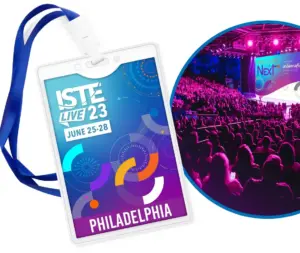Trying to decipher the inclinations of the display market in a peculiar post-covid world remains ever challenging. One way to approach it is to observe, from a worm’s eye view untainted by the predictable exuberance of vendors, what has been happening in post-pandemic conference exhibit halls. Let’s start with the K-12 ed-tech expo experience.
The first educational technology conference and expo in 2023, FETC, was held in New Orleans, and it was the first time it had been held face-to-face since the pandemic. A long-time friend and exhibitor, with hundreds of conference booths under his belt, returned from the FETC exhibits with quite a story to tell. He noticed several impediments, leading to a more enfeebled expo experience for all involved. First, educators as a group were still palpably fearful. Most were masked. When lining up for opening day entry to the exhibit hall, educators were standing in the large entry way, six feet apart. When approaching booths to engage with presenters, educators kept their distance.
This visceral apprehension took its toll on the expo experience. The roar of first-day entry by educators was absent. It took a long time for educational customers to percolate their way into the aisles and byways of the exhibit hall, so the aisles were noticeably quieter. The buzz and excitement of the day was subdued. Sales folks manning their booths couldn’t hear what customers were saying or asking, since they stood at a distance and their words were muffled by masks. Still, as the conference went on, attitudes eased a bit and exchanges improved noticeably.
As more ed-tech conferences appeared on the calendar, I began an environmental scan of exhibit hall photos posted on LinkedIn and elsewhere. No matter how hard I looked, traffic in expo halls seemed anemic. I also noticed something I hadn’t seen very often: “free” expo passes being offered front-and-center on conference websites, to draw in more educators.
Next, let’s fast forward to last month’s ed-tech conference and expo, ISTE 2023 Live, which has historically been the nation’s largest. Although masks were largely gone, social distancing continued, but for a different reason: lagging attendance. ISTE’s own data charts showed conference attendance had dipped to 12,000 attendees in Philadelphia, down from 15,000, 18,000, and 14,000 in previous years. This lower attendance played out despite the pandemic having been declared “over.” My follow up environmental scan of multitudes of exhibit hall photos showed the same relative asthenic state of attendance again at play.
As stated previously, these observations are only indicative of post-pandemic K-12 ed-tech conferences and expos. I am wondering if the same lackluster story is consistent with other verticals, such as healthcare or government. I am also wondering if a restorative or a nonregenerative future looms ahead. That’s your cue to respond to this post, providing your own take in the verticals you have experienced, using the response prompts immediately below. Let’s see what the crowd says.

